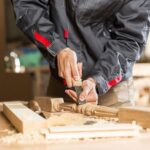Are you wondering how to mount Irwin woodworking vise onto your workbench? An Irwin woodworking vise is an essential tool for holding and securing wood pieces during various woodworking tasks.
Properly mounting the vise is crucial to ensure stability and safety while working on your projects. In this article, we will guide you through the process of mounting an Irwin woodworking vise, including the tools and materials needed, choosing the right location, preparing the workbench, step-by-step instructions for mounting, testing and adjustments, safety precautions, and maintenance tips.
Before you begin the process of mounting your Irwin woodworking vise, it is important to gather all the necessary tools and materials. The right tools such as a drill, screws, screwdriver, and measuring tape are essential for a successful installation.
Additionally, ensuring that you have a sturdy workbench and appropriate space for the vise is crucial for its effective usage. Choosing the right location for mounting your vise will also play a significant role in its functionality and convenience during woodworking tasks.
Properly mounted Irwin woodworking vise provides stability and security while working on your projects. As such, selecting the right location on your workbench becomes crucial. In addition to that, preparing the workbench with accurate measurements and markings ensures a secure fit for your vise. By following these steps carefully, you can guarantee a stable and reliable foundation for all your future woodworking endeavors.
Tools and Materials Needed
When it comes to mounting an Irwin woodworking vise, having the right tools and materials is crucial for a successful installation. To ensure a secure and stable mounting, you will need the following tools and materials:
1. Drill: A power drill will be necessary for creating holes in the workbench for attaching the vise.
2. Bench Vise: In addition to the Irwin woodworking vise itself, you may need a bench vise to hold the workbench steady while mounting the vise.
3. Screws: Depending on the specific model of your Irwin woodworking vise, you will need screws of appropriate size and length for securing it to the workbench.
4. Wrench or Socket Set: These tools will be needed for tightening and securing the screws into place.
5. Measuring Tape: Accurate measurements are essential for marking out where the vise will be mounted on the workbench.
6. Pencil or Marker: You’ll need this to mark out the drilling holes and measuring points on the workbench before mounting.
7. Safety Gear: It’s important to use protective eyewear and gloves while handling tools and materials during the mounting process.
By ensuring that you have all these tools and materials ready before starting, you can avoid any interruptions or delays during the mounting process of your Irwin woodworking vise on your workbench. Now that we’ve covered what’s needed let’s move onto choosing the right location for mounting your Irwin woodworking vice.
Choosing the Right Location
Factors to Consider
Firstly, you must consider the height at which you want the vise to be mounted. This will depend on your own height, as well as the type of work you will be doing with the vise. It’s important to choose a height that allows you to comfortably work with the vise without straining or bending unnaturally.
Workbench Stability
Another crucial factor to consider is the stability of your workbench. The location you choose for mounting the vise should be on a sturdy part of the bench that can support the weight and pressure applied when using the vise. If your workbench is wobbly or unstable, it may affect the effectiveness of the vise and pose a safety risk during use.
Workspace Accessibility
In addition, consider how accessible the mounted vise will be in relation to your other workspace requirements. Make sure that mounting the vise in a certain location will not hinder access to other tools or impede movement around your work area.
Considering these factors and making an informed decision about where to mount your Irwin woodworking vise will ensure that it enhances rather than hinders your woodworking experience and projects.
Preparing the Workbench
When preparing to mount an Irwin woodworking vise, it is crucial to ensure that the workbench is properly prepared for the installation. This section will provide a detailed guide on how to prepare the workbench for mounting the vise, including measurements and marking.
The first step in preparing the workbench is to determine the ideal location for mounting the vise. It is essential to choose a sturdy area of the workbench that can support the weight and pressure applied when using the vise. Additionally, consider factors such as accessibility and clearance around the chosen location to ensure ease of use.
Once the location has been selected, it’s time to take precise measurements and mark the drilling points. Using a measuring tape and pencil, mark the exact placement of where the vise will be mounted on the workbench. This will ensure that the vise is positioned accurately and securely, preventing any unnecessary adjustments or rework later on.
After marking the drilling points, it is important to double-check the measurements and markings before proceeding with drilling. Accuracy at this stage is critical to ensure that the Irwin woodworking vise is mounted securely and functions efficiently. Taking these preparatory steps will set a solid foundation for successfully mounting the vise onto the workbench.
From here, you can then follow through with mounting your Irwin woodworking vice according to your marks using your tools and materials from earlier in order to have your new tool ready for use.
Mounting the Vise
Mounting the Irwin woodworking vise onto your workbench is a crucial step in setting up your woodworking space. Properly mounting the vise ensures stability and security when working on various wood projects. In this section, we will provide a detailed guide on how to securely mount the Irwin woodworking vise onto the workbench, including step-by-step instructions for a successful installation.
Tools and Materials Needed
Before starting the mounting process, it’s important to gather all the necessary tools and materials. Here’s what you’ll need:
Choosing the Right Location
Choosing the right location for mounting the vise is essential for efficient woodworking. Consider these factors when determining where to mount your vise:
– Height and accessibility: The vise should be mounted at a comfortable working height to avoid strain.
– Workbench structure: Identify a strong and sturdy area of your workbench where the vise can be securely attached.
– Clearance: Ensure that there is enough clearance around the vise handle for easy operation.
Mounting Steps
1. Positioning: Place the vise in your desired location on the workbench.
2. Marking: Use a pencil to mark the locations of the screw holes on both sides of the vise.
3. Pre-drilling: Use an electric drill equipped with an appropriate bit to pre-drill pilot holes at each marked location.
4. Attaching: Securely fasten the vise onto the workbench using screws and a screwdriver. Be sure to check that it is level during installation.
By following these steps, you can ensure that your Irwin woodworking vise is securely mounted onto your workbench, providing you with a stable and reliable tool for all your woodworking projects.
Testing and Adjustments
After successfully mounting the Irwin woodworking vise onto your workbench, the next crucial step is to test its functionality and make any necessary adjustments for stability. This process is essential to ensure that the vise operates smoothly and securely, providing a reliable grip for your woodworking projects.
Testing the Vise:
- Begin by placing a piece of scrap wood between the vise jaws and tightening it securely.
- Apply gentle pressure to the mounted piece of wood to test the vise’s grip and stability.
- Check for any wobbling or movement in the vise as you apply pressure. This will indicate whether the vise is securely mounted on the workbench.
Making Adjustments:
Once you have tested the vise, you may need to make some adjustments to ensure its stability and functionality. Here’s how:
- If you notice any wobbling or movement during testing, use a level to check if the workbench surface is even. If not, shim any gaps beneath the vise with wooden shims.
- Inspect the mounting bolts and hardware for any signs of loosening or instability. Tighten them as needed to secure the vise firmly in place.
- Lubricate any moving parts of the vise using an appropriate lubricant, such as grease or oil, to ensure smooth operation.
By following these testing and adjustment procedures, you can ensure that your mounted Irwin woodworking vise provides a stable and secure grip for all your woodworking projects. Taking the time to properly test and make necessary adjustments will contribute to a safer and more efficient work environment.
Safety Precautions
Mounting an Irwin woodworking vise is a crucial task that requires careful attention to safety precautions to avoid any accidents or injuries. Safety should always be a top priority when working with tools and mounting equipment, and the same applies to installing a woodworking vise. There are several key safety measures that should be taken into consideration when mounting the vise onto a workbench.
First and foremost, it is essential to wear appropriate personal protective equipment (PPE) such as safety goggles and gloves when handling the vise and using tools during the installation process. This will help protect your eyes from any debris or metal shavings that may result from drilling or fastening the vise onto the workbench. Additionally, wearing gloves will provide added protection for your hands while handling heavy or sharp components of the vise.
Furthermore, it is important to ensure that the work area where the mounting will take place is clear of any obstacles or clutter. This will prevent any tripping hazards and make it easier to maneuver around the workbench while securing the vise in place. In addition, keeping the work area clean also reduces any potential distractions that could lead to accidents during the installation process.
Another crucial safety measure is to use the right tools for mounting the Irwin woodworking vise. Using improper or damaged tools can increase the risk of accidents, so it is important to ensure that all tools are in good working condition before beginning the installation process. Additionally, using tools that are designed for specific tasks, such as drills and clamps meant for woodworking applications, will help ensure a smoother and safer mounting process.
Finally, it is important to double-check all measurements and markings on the workbench before drilling or fastening anything in place. Taking accurate measurements and carefully marking out where the vise will be mounted will help reduce mistakes and minimize any potential risks during the installation process.
| Safety Precautions | Description |
|---|---|
| Wear PPE | Wear safety goggles and gloves for eye protection and hand safety. |
| Clean Work Area | Clear work area of clutter and obstacles to prevent tripping hazards. |
| Use Proper Tools | Ensure all tools are in good condition and use tools designed for woodworking applications. |
Maintenance and Care
In conclusion, mounting an Irwin woodworking vise is a crucial task that requires careful consideration and attention to detail. The proper installation of the vise not only ensures its stability and functionality but also contributes to the safety of the user. By following the steps outlined in this guide, individuals can effectively mount their Irwin woodworking vise onto their workbench, providing a reliable tool for their woodworking projects.
After successfully mounting the vise, it is essential to test its functionality and make any necessary adjustments for stability. This step ensures that the vise is securely installed and ready for use. Additionally, users must adhere to safety precautions while mounting the vise to prevent accidents and injuries, emphasizing the importance of taking necessary measures during the installation process.
Lastly, to maintain the efficiency and longevity of the mounted vise, proper care and maintenance are crucial. Simple practices such as regular cleaning, lubrication of moving parts, and inspection for any signs of wear or damage can significantly extend the lifespan of the vise. By following these maintenance tips, woodworkers can ensure that their Irwin woodworking vise remains in top-notch condition for years to come, providing reliable support for their woodworking endeavors.
Frequently Asked Questions
How Do You Install a Woodworking Vise?
Installing a woodworking vise involves careful measurement and marking of where the vise will be placed on the workbench. Pre-drilling holes for the mounting screws is important, as well as ensuring that the vise is level before tightening the screws securely.
Where Is the Best Place to Mount a Vise on a Workbench?
The best place to mount a vise on a workbench is generally on the front left corner, as it provides easy access and allows for long pieces of wood to be held securely. It’s important to consider how you will be using the vise and which placement will provide the most convenience and functionality.
How Do I Fix My Vice to Workbench?
Fixing a vice to a workbench requires drilling pilot holes into the underside of the bench where you want to mount the vice. Then, secure the vice in place with bolts through these holes, making sure it’s level before fully tightening them. Adding washers can help distribute pressure and prevent damage to the wood.

Hi everyone! I’m a woodworker and blogger, and this is my woodworking blog. In my blog, I share tips and tricks for woodworkers of all skill levels, as well as project ideas that you can try yourself.





